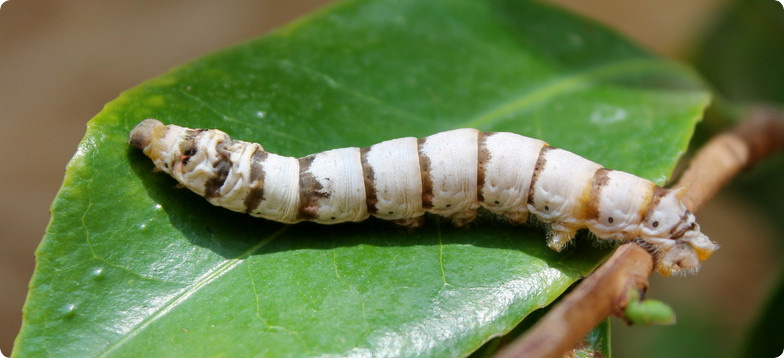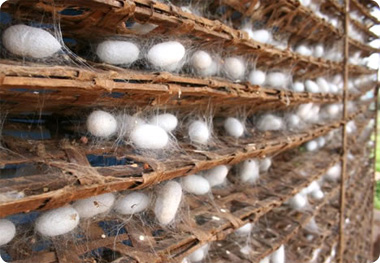
Here's our take at de-mystifying silk!
Silk has been a popular fiber for thousands of years. Used to weave the robes of emperors and kings across Asia and Europe, sari’s in India, the earliest example of silk fabric is from 3630 BC from burial wrappings. Today it is used for all kinds of clothing, home textiles and even medical textile applications.
The legend of how silk was discovered-
The legend goes that a Chinese empress was having her tea when a cocoon fell from a mulberry tree above her into the hot tea. When she went to retrieve it with her chopsticks a strand of the silk began to unwind from the cocoon, and so the fiber and method of reeling it were discovered at the same time. Of course we can not verify this but it is a lovely story.
Types of Silk
The fiber we think of as silk comes from the cocoons of the larvae of the mulberry silkworm Bombyx mori.

Wild Silk (Tussah Silk)
This silk is made from cocoons collected in the wild. Because the caterpillars have a more varied diet the silk is generally a darker light fawn color. This darker silk still dyes beautifully with slightly deeper tones due to its natural coloration. Obviously this type of silk is very expensive.
 Cultivated Silk (Bombyx Silk)
Cultivated Silk (Bombyx Silk)
This silk is gathered from cocoons spun by caterpillars that have been raised on silk farms. The silkworms are fed a diet exclusively made of mulberry leaves which makes the silk whiter and much more consistent in quality. It is then normally bleached white with a peroxide to make the white silks that most prefer for dyeing, bridal wear, etc. This is the most common, and most affordable silk, mostly coming from China. It comes in many weaves, from the most diaphanous gauze to the most luxurious charmeuse satins and crepes. It may be extremely shiny (satin) or more dull (crepe) depending on the weave. This is the most common type of silk, and is what is carried by Dharma and most other silk suppliers. The Raw Silk or Silk Noil mentioned above that we also carry is cultivated silk. Raw silk is the cocoon leftovers, ie. broken fibers instead of long continuous ones, that are not cleaned very much, so is more of a light tan color, and are woven into a rougher, non-shiny, but is a heavier sturdy fabric.
Peace Silk (Humane Silk)
This silk can be cultivated or wild but instead of collecting the cocoons before the moths emerge they are collected after the moth has worked its way out of the cocoon. The silk that comes from these cocoons is no longer a continuous strand so it used to make thicker textured silk yarns that are full of broken strands, and therefore, thicker fabrics, since it can not be reeled off into fine strands. The look and smell of it is very similar to that of Raw Silk (Silk Noil), which is made from the leftover defective cocoons that also have broken, non-continuous fibers. Peace Silk, however, is much more expensive than Raw silk.
Other Sources of Silk
- Spider Silk- Spiders spin several different types of silk to build their webs and egg sacks. Talk about expensive! Probably the strongest silk available. Video- TedTalk on Spider Silk.
- Golden Silk collected from over a million female Madagascar Orb Weaver Spiders was used to make this shawl.
- Butterfly and Moth Silk- many moths and butterflies spin cocoons of silk during their metamorphosis but most are not suitable for collection or are harder to cultivate.
- Goat Silk- Yes, we said GOAT! A team of geneticists at Utah State University have raised goats that produce silk proteins in their milk. So while the goats don't spin the silk the proteins can be isolated and then spun into silk. They want to be able to have a larger supply of silk proteins than they can easily obtain from spiders to help further speed research on silk. Read here for more information.
Some Common Myths about Silk
Silk is weak and must be hand washed
Many people think that silk is a weak fiber and must be gently handled all the time, but this is not true. Silk is one of the strongest natural fibers and out of all protein fibers has the highest tenacity. Silk can absorb one third its weight in water before it even feels wet so it is highly absorbent (though less so than wool.) While it is weaker when fully saturated, because the fibers are swollen, most modern home washing machines will not damage silk fabrics. Even the lightest of silk fabrics can be washed on the delicates cycle when put into a mesh delicates bag. Use a mild detergent, avoid bleach (ruins silk!) and when rinsing, a fabric softener like Milsoft will help restore the hand of the fabric. Hot water does not damage silk. After all, most cocoons are boiled before processing, and silk is dyed in very hot water. Agitation (from the washing machine) and sudden temperature changes cause the shrinkage, not the hot water. Alkalis, like soda ash, or many detergents, can however chemically damage silk, which will reduce its sheen (best case) or even "rot" it with extreme exposure(worst case), also it is normally dyed with dyes using a mild acid as the fixative, and washed in mild soaps that are neutral or slightly acidic. The reason labels often say to wash in cold water is not to protect the silk, but because the Acid Dyes that it is dyed with are very susceptible to bleeding in hot water.
Silk is hard to dye
Somehow silk got the reputation of being hard to dye because of the need to use heat in setting the dyes, but if you can make a pot of pasta you can dye silk. Acid Dyes such as our Dharma Acid Dyes or Jacquard Acid Dyes are easy to use on the stove or even in the washing machine and all you need besides your washed silk is some white vinegar. We walk you through tub dyeing with acid dyes in this great tutorial here. And if that isn’t easy enough check out our 5 Minute Scarf that uses the microwave to set the dye.
Silk is hard to sew
Many beginning sewers are afraid to try their hand at silk. True, there is a little more to sewing with silks than cottons or rayons. There are a few tips and tricks that will make sewing with silk much easier the first time around.
- Start with a slightly textured silk, Crepe de Chine and basic Habotai are going to be easier to handle then slippery Satins or floaty Chiffon.
- Layer your silk with tissue paper for cutting and sewing, some pattern weights will help hold everything down while you cut out the fabric and the tissue will keep the fabric in place while you cut and under the sewing machine foot. When you are doing sewing just rip the paper away from the seam.
- Make sure you have the right kind of needle on your sewing machine, for silk you want a finer sharp needle so that you will not have large holes and to slip between the fine fibers of the silk. Sizes 60/8 – 90/14, the folks at your local sewing machine outlet can help.
- Make sure your shears are sharp or that you have a fresh blade in your rotary cutter. I tend to use a new blade for silk and then downgrade it after a little while to cottons and then lastly papers.
- If you have a particularly slippery silk, transfer your pattern to freezer paper, then lightly iron it to the fabric before cutting it out. The fabric won’t move and you can gently peel it off before sewing.
- Start with a simple pattern any time you are sewing a new fabric for the first time, this is a great free basic silk t-shirt tutorial from Runaway Sewing.
Mulberry Silk is rare, expensive, and the best silk you can buy
There are websites out there that sell super expensive items made of so called Mulberry Silk, ie silk made by silkworms that are fed mulberry leaves. Since the food of choice and survival is mulberry leaves, most silkworms, including the ones that make our silk, are fed mulberry leaves. Apparently some can also eat Osage Orange, but this is not normal procedure. So this is basically marketing hype to get more money. This is actually the best quality, but also the most common silk, and therefore, the least expensive. It is the weight and complexity of the weave that increase the price, with the most luxurious weaves commanding the highest prices.
Silk is a wondrous fiber that has stood the test of the ages. We hope this helps you in planning your first (or next) silk project.
Check out our Dharma Email Newsletters and our Silk Pinterest board throughout the year as we add more information.











